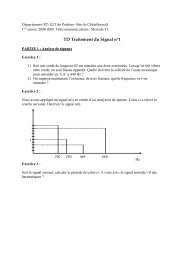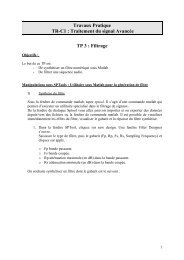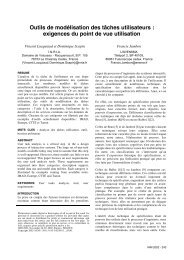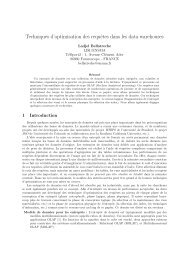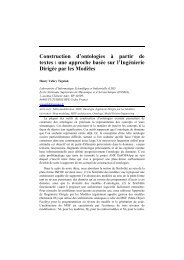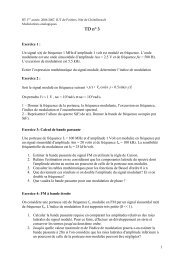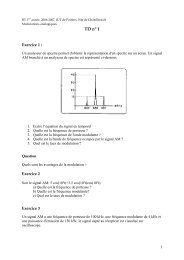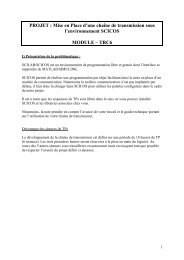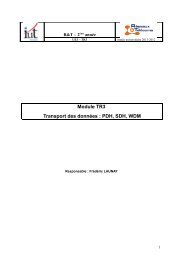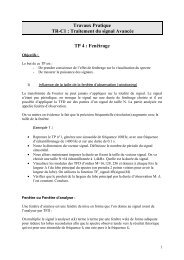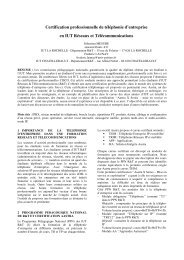Recursive subspace identification for in-flight modal ... - ResearchGate
Recursive subspace identification for in-flight modal ... - ResearchGate
Recursive subspace identification for in-flight modal ... - ResearchGate
Create successful ePaper yourself
Turn your PDF publications into a flip-book with our unique Google optimized e-Paper software.
FLITE EUREKA 2 1567<br />
Subsequently, the elements of ¯z p,s+1 are zeroed <strong>in</strong> a similar way, to give<br />
⎛<br />
⎞<br />
L 11,s+1 0 0 0<br />
⎝L 21,s+1 L 22,s+1 0 0 ⎠ .<br />
L 31,s+1 L 32,s+1 L 33,s ¯z f,s+1<br />
Then it is easy to show that the “square” of block L 32,s+1 can be written as [10, 12]<br />
L 32,s+1 L T 32,s+1 = L 32,s L T 32,s + ¯z f,s+1¯z T f,s+1 − ¯z f,s+1¯z T f,s+1 .<br />
Thus, <strong>in</strong> this case, the <strong>subspace</strong> estimate at time s + 1 is related to{<br />
the one at time s via the comb<strong>in</strong>ation }<br />
of an update and a downdate. Furthermore, by denot<strong>in</strong>g R zf = E ¯z f,s+1¯z T f,s+1 − ¯z f,s+1¯z T f,s+1 , it holds<br />
that [11]<br />
R zf = Γ i E { x i+j+1 x T i+j+1}<br />
Γ<br />
T<br />
i = Γ i R x Γ T i .<br />
The second step of this recursive <strong>subspace</strong> method consists <strong>in</strong> the onl<strong>in</strong>e update of the observability matrix.<br />
In this paper, the focus will be on algorithms based on the propagator concept [15]. More precisely, under<br />
the assumption that the pair {A, C} is observable, s<strong>in</strong>ce Γ i ∈ R li×n with li > n, the extended observability<br />
matrix has n l<strong>in</strong>early <strong>in</strong>dependent rows, which can be gathered <strong>in</strong> a submatrix Γ i1 . Then, the complement<br />
Γ i2 , i.e. the matrix consist<strong>in</strong>g of the rows of Γ i that are not <strong>in</strong> Γ i1 , can be expressed as a l<strong>in</strong>ear comb<strong>in</strong>ation<br />
of the n rows <strong>in</strong> Γ i1 . So, there is a unique l<strong>in</strong>ear operator<br />
(<br />
P ∈<br />
)<br />
R n×(li−n) , named propagator [15], such that<br />
Γ i2 = P T In<br />
Γ i1 . Furthermore, it is easy to verify that Γ i =<br />
P T Γ i1 . Thus, s<strong>in</strong>ce rank {Γ i1 } = n,<br />
span col {Γ i } = span col<br />
{(<br />
In<br />
P T )}<br />
. (2)<br />
Equation (2) implies that it is possible to estimate the observability matrix (<strong>in</strong> a particular basis) by estimat<strong>in</strong>g<br />
the propagator. For that purpose, consider the follow<strong>in</strong>g partitions:<br />
)<br />
)<br />
(¯zf1 ,s+1<br />
(¯z<br />
¯z f,s+1 = and ¯z f,s+1 =<br />
f1 ,s+1<br />
,<br />
¯z f2 ,s+1<br />
¯z f2 ,s+1<br />
where ¯z f1 ,s+1 ∈ R n×1 (respectively ¯z f1 ,s+1) and ¯z f2 ,s+1 ∈ R (li−n)×1 (respectively ¯z f2 ,s+1) are the components<br />
of ¯z f,s+1 (respectively ¯z f,s+1 ) correspond<strong>in</strong>g to Γ i1 and Γ i2 . Then, it is straight<strong>for</strong>ward to show<br />
that 3 ) (<br />
) −1<br />
ˆP T =<br />
(R¯zf2¯z f1<br />
− R¯z f2¯z f1<br />
R¯zf1 − R¯z f1 .<br />
This estimated matrix corresponds to the optimum of the follow<strong>in</strong>g cost function<br />
J(P ) = E ∥ ∥¯z f2 − P T ¯z f1<br />
∥ ∥<br />
2<br />
− E<br />
∥ ∥¯z f2 − P T ¯z f1<br />
∥ ∥<br />
2<br />
,<br />
the m<strong>in</strong>imization of which is given by the follow<strong>in</strong>g recursive algorithm 4<br />
L f,s+1 = 1 λ<br />
(<br />
L f,s<br />
− L f,s¯z f 1 ,s+1¯z T f 1 ,s+1 L f,s<br />
λ + ¯z T f 1 ,s+1 L f,s¯z f 1 ,s+1<br />
L f,s+1<br />
= L f,s+1 + L f,s+1¯z f1 ,s+1¯z T f 1 ,s+1 L f,s+1<br />
1 − ¯z T f 1 ,s+1 L f,s+1¯z f1 ,s+1<br />
)<br />
P T s+1 = P T s + (¯z f2 ,s+1 − P T s ¯z f1 ,s+1)<br />
¯z<br />
T<br />
f1 ,s+1 L f,s+1 − (¯z f2 ,s+1 − P T s ¯z f1 ,s+1)<br />
¯z T f 1 ,s+1 L f,s+1 .<br />
3 The follow<strong>in</strong>g notation is used <strong>for</strong> covariance matrices: E ¨ab T © = R ab , with R aa = R a.<br />
4 λ is a <strong>for</strong>gett<strong>in</strong>g factor <strong>in</strong>troduced to weight the past <strong>in</strong><strong>for</strong>mation.



